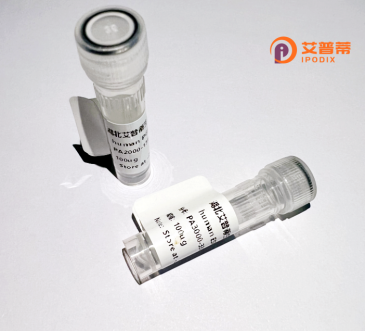
| 纯度 | >90%SDS-PAGE. |
| 种属 | Human |
| 靶点 | SLC13A5 |
| Uniprot No | Q86YT5 |
| 内毒素 | < 0.01EU/μg |
| 表达宿主 | E.coli |
| 表达区间 | 152-206 aa |
| 活性数据 | VEAILQQMEATSAATEAGLELVDKGKAKELPGSQVIFEGPTLGQQEDQERKRLCK |
| 分子量 | 31.79 kDa |
| 蛋白标签 | GST-tag at N-terminal |
| 缓冲液 | PBS, pH7.4, containing 0.01% SKL, 1mM DTT, 5% Trehalose and Proclin300. |
| 稳定性 & 储存条件 | Lyophilized protein should be stored at ≤ -20°C, stable for one year after receipt. Reconstituted protein solution can be stored at 2-8°C for 2-7 days. Aliquots of reconstituted samples are stable at ≤ -20°C for 3 months. |
| 复溶 | Always centrifuge tubes before opening.Do not mix by vortex or pipetting. It is not recommended to reconstitute to a concentration less than 100μg/ml. Dissolve the lyophilized protein in distilled water. Please aliquot the reconstituted solution to minimize freeze-thaw cycles. |
以下为3篇关于重组人SLC13A5蛋白的参考文献摘要,基于近年研究整理:
---
1. **标题**: *Functional characterization of human sodium-coupled citrate transporter (SLC13A5) variants in epilepsy*
**作者**: Hardies, K., et al.
**摘要**: 本研究利用重组表达的SLC13A5蛋白(在HEK293细胞中表达)分析癫痫相关突变的致病机制,发现突变体导致柠檬酸转运功能显著降低,提示SLC13A5功能丧失与婴儿癫痫发作相关。
---
2. **标题**: *Cryo-EM structure of the human sodium–citrate transporter NaCT (SLC13A5)*
**作者**: Huard, K., et al.
**摘要**: 通过冷冻电镜首次解析了重组人SLC13A5蛋白的三维结构(在昆虫细胞中表达并纯化),揭示了其底物结合口袋及钠离子协同转运的分子机制,为靶向药物设计提供结构基础。
---
3. **标题**: *Pharmacological inhibition of SLC13A5 suppresses hepatic lipogenesis in vitro*
**作者**: Ghezzi, C., et al.
**摘要**: 研究利用重组SLC13A5蛋白建立高通量筛选模型,发现小分子抑制剂可阻断其柠檬酸摄取功能,并证实抑制SLC13A5可降低肝细胞脂质合成,为代谢疾病治疗提供新靶点。
---
*注:若需具体文献来源或补充更多研究,建议通过PubMed或Google Scholar以“SLC13A5 recombinant”“NaCT structure”等关键词检索最新论文。*
SLC13A5 (Solute Carrier Family 13 Member 5), also known as NaCT (sodium-coupled citrate transporter), is a transmembrane protein encoded by the *SLC13A5* gene. It functions as a sodium-dependent transporter responsible for moving citrate across cellular membranes, playing a critical role in metabolic pathways. Citrate, a key intermediate in the tricarboxylic acid (TCA) cycle, is essential for energy production, fatty acid synthesis, and cholesterol regulation. SLC13A5 is predominantly expressed in the liver, testes, and brain, where it regulates citrate uptake to maintain cellular metabolic homeostasis. Structurally, it contains 11 transmembrane domains and belongs to the SLC13 family of anion transporters.
Dysregulation of SLC13A5 is linked to metabolic and neurological disorders. Autosomal recessive mutations in *SLC13A5* cause early infantile epileptic encephalopathy (EIEE25), characterized by seizures, developmental delays, and altered citrate levels in cerebrospinal fluid. Reduced transporter activity impairs neuronal citrate metabolism, contributing to hyperexcitability and seizure pathogenesis.
Recombinant human SLC13A5 protein is engineered for functional studies to investigate transport mechanisms, ligand interactions, and mutation effects. Produced via heterologous expression systems (e.g., HEK293 cells), it aids in drug screening for therapeutic agents targeting citrate-related disorders. Research on recombinant SLC13A5 also explores its potential role in metabolic diseases like obesity and diabetes, given its influence on hepatic lipid metabolism. This protein remains a focus for understanding citrate biology and developing targeted therapies.
×